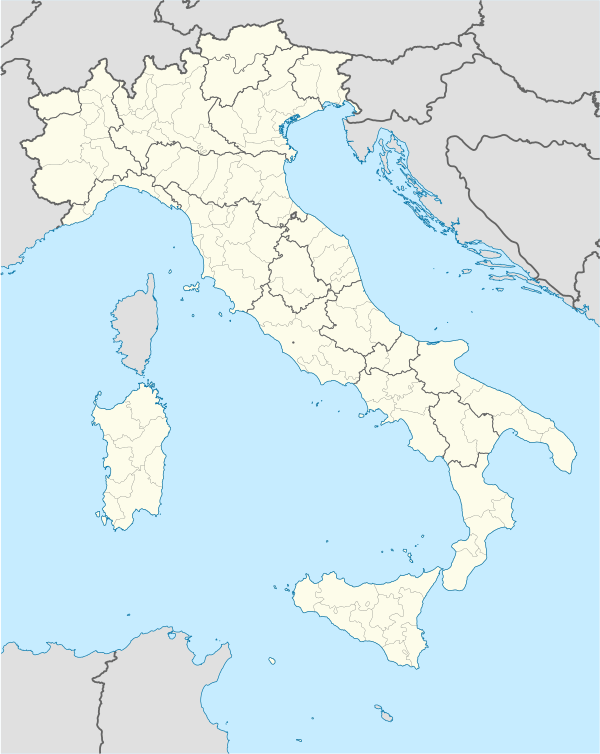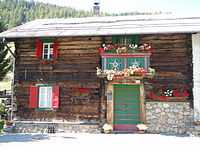Livigno
| Livigno | |
|---|---|
| Comune | |
| Comune di Livigno | |
 | |
 Livigno Location of Livigno in Italy | |
| Coordinates: 46°32′N 10°08′E / 46.533°N 10.133°ECoordinates: 46°32′N 10°08′E / 46.533°N 10.133°E | |
| Country | Italy |
| Region | Lombardy |
| Province | Sondrio (SO) |
| Frazioni | Trepalle |
| Government | |
| • Mayor | Damiano Bormolini |
| Area | |
| • Total | 227.3 km2 (87.8 sq mi) |
| Elevation | 1,816 m (5,958 ft) |
| Population (31 May 2014) | |
| • Total | 6,292 |
| • Density | 28/km2 (72/sq mi) |
| Demonym | Livignaschi |
| Time zone | CET (UTC+1) |
| • Summer (DST) | CEST (UTC+2) |
| Postal code | 23030 |
| Dialing code | 0342 |
| Patron saint | Holy Mary / Saint Anna (for Trepalle) |
| Saint day | 8 September / 21 July (for Trepalle) |
| Website | Official website |
Livigno (Italian: Livigno, local Lombard: Livígn, German: Luwin) is a town and comune in the province of Sondrio, in the region of Lombardy, Italy, located in the Italian Alps, near the Swiss border.
History
Livigno's first settlers were probably shepherds during the Middle Ages. The first documents called this area "vinea et vineola". This Latin name does not refer to the presence of vineyards in the area, but comes from the German language, meaning "avalanche". The valley has always been at risk from this point of view. The last avalanche hitting the village was in 1951, which caused seven deaths and damage to a dozen houses.
Politically, Livigno has always followed Bormio's history, although the relationships between the two communes have always been tense, Bormio being dominant and more populous than Livigno. Until the 1970s Livigno was a farming village. In recent decades, however, things have changed, and nowadays Livigno enjoys a better economic situation and a higher number of inhabitants. Livigno has recently enjoyed one of Italy's highest birth rates (19.4 births per 1000 inhabitants).[1] Livigno's economy is based on tourism, both in winter and in summer, and on its duty-free status, with goods sold at bargain prices.
Building companies, craft industry and agriculture are somewhat developed, but all these sectors are in various ways linked to the main source of income.
Main sights
Saint Mary's parish church was built at the end of the 19th century, on a previous church. The current building incorporated the previous one, which was left standing until the end of works, allowing church services to be carried out as usual.
Other buildings of note are the Caravaggio church, with some ex voto paintings and a picture which is traditionally attributed to Caravaggio, and Saint Rocco church, built at the beginning of the 16th century as an offering for protecting the village against plague. Other sights are represented by the breathtaking panorama, with high peaked mountains and marvellous valleys.
Duty-free status
Livigno enjoys a special tax status as a duty-free area. Italian VAT (Value Added Tax) is not paid. Although tax advantages for Livigno were recorded as far back as the sixteenth century, the current tax exemption was first introduced by the Austrian Empire around 1840. It was then confirmed by the Kingdom of Italy around 1910, then by the Italian Republic and the European Economic Community in 1960. Although no VAT is paid, income taxes are, thus Livigno cannot be considered as a tax haven.
The justification for such a status is the difficulty in reaching Livigno during winter, and the centuries-long history of poverty in the region. The various states wanted to ensure people would have an incentive to live in the area (so that they could claim it territorially). At the same time, the tax revenue from Livigno would have been negligible.
Only three roads lead to the town. Two link to Switzerland, one through the Forcola di Livigno, elevation 2,315 metres (7,595 ft) and open in summer only, and the second through the Munt La Schera tunnel. The third road connects to other parts of Italy through the Foscagno Pass, elevation 2,291 metres (7,516 ft). Given the increase in wealth in recent decades, the improvement of roads and the widespread availability of cars, many outsiders see this exemption as an unjustified privilege, although it sustains several hundred jobs.
Leaving Livigno into the rest of Italy on the road there is a custom checkpoint manned by Guardia di Finanza militaries. Entering or leaving from Switzerland there is both Guardia di Finanza militaries and Swiss Border Guards.
Economy
Livigno once made a living from agriculture and a little commerce. Smuggling was both widespread and not socially deprecated, being often the only way to survive in such a harsh environment. This generated some prejudice in the remaining population of Valtellina, where smuggling was also widespread, with the local proverb gent de cunfin, tücc' lader o asesin, or "border people, all thieves or murderers".
Nowadays Livigno is a rich area, and the main activities are linked to tourism, especially as a ski resort. Many inhabitants of Valtellina visit once in a while to buy goods at substantially lower prices, especially tax-free gasoline, sometimes from as far as Sondrio. The tax free allowance for tourists applied here is the same as the one applied to travellers coming from any non EU country.
The 2005 Union Cycliste Internationale mountain biking world championships were held here, from 28 August to 4 September.
Geography

Livigno is 1,816 metres (5,958 ft) above sea level. Livigno's main river is called Aqua Granda or Spöl. Trepalle, a frazione in the municipality of Livigno, is considered Europe's highest inhabited parish. Livigno was once a traditional and cultural village. Livigno is one of the few Italian villages which do not belong to the drainage basin of the Mediterranean Sea but to the Black Sea basin. A part of the old village was completely destroyed in the 1960s by the creation of a reservoir, the Lago di Livigno.
Climate
| Month | Jan | Feb | Mar | Apr | May | Jun | Jul | Aug | Sep | Oct | Nov | Dec | Year |
|---|---|---|---|---|---|---|---|---|---|---|---|---|---|
| Average high °C (°F) | −3 (27) |
−2 (28) |
1 (34) |
5 (41) |
10 (50) |
14 (57) |
16 (61) |
15 (59) |
13 (55) |
8 (46) |
1 (34) |
−3 (27) |
6.3 (43.3) |
| Average low °C (°F) | −15 (5) |
−13 (9) |
−9 (16) |
−5 (23) |
−1 (30) |
3 (37) |
5 (41) |
5 (41) |
3 (37) |
−1 (30) |
−6 (21) |
−11 (12) |
−3.7 (25.2) |
| Source: Stazione Metereologica Livigno | |||||||||||||
Culture and sport
Despite its small size, there are many cultural organizations in Livigno. Some of these are:
- Corpo Musicale, a local street band
- Gruppo folkloristico, a folk group
- Monteneve Chorus
- Carcent theatre group [2]
- A few rock/pop bands, the most well-known being MetalDreit
The mass-media sector is quite developed as well. In the 1980s a local radio, Radio Alteuropa, used to broadcast from Livigno, covering up to a wide part of the neighbouring Valtellina valley. The local monthly newspaper, Al Restel,[3] was founded in the same period and it is still published today.
Nowadays, most of information is given by a TV channel, TeleMonteNeve,[4] which broadcasts the city council's meetings, a news report three times a week and other information both for residents and for tourists. On-line new media is also growing. An example is Senzaiva, an on-line cultural magazine. Its name means "without VAT", referring to the special duty-free status of Livigno and of all cultural products.[5]

The local dialect, intermediate between Romansh and Lombard, has been categorized in a dictionary, funded by the local administration. This language variety is used locally in street names and in some other signs, as well as on the official maps.
Sport also plays an important role. In Livigno there are nearly 20 sport associations, most of them are supported by an association called Sporting Club.[6] Many young athletes often end up with good results in their discipline (see Notable people below). In 2006 Turin winter Olympics, no less than eight Italian athletes came from Livigno.
In 2015, Livigno was home to the European Freeride Festival which ran between January 31st and February 4th.[7]
Chess
Since 2010 the International Livigno Chess Open has taken place, organized by the local chess club. It has attracted people from all over the world. Winner for 2010 was GM Igor Naumkin,[8] in 2011 GM Sergey Volkov [9] (both from Russia) and in 2012 the Italian GM Alberto David.[10] These tournaments also proved successful, so that even the Fide (World Chess Federation) has mentioned them.[11]
Notable people
- Giorgio Rocca, Italian skier (winner of slalom specialty cup in 2006 Alpine Skiing World Cup)
- Gianluigi Galli (better known as Gigi Galli), rally car driver in World Rally Championship
- Daniela Zini, Italian team skier (9th place in 1980 Alpine Skiing World Cup)
- Katia Zini and Mara Zini (bronze medal winners in short track speed skating in 2006 Winter Olympics in Turin)
- Iwan Bormolini, Italian world cup ski-racer
- Marianna Longa, Cross-country skier in Italy's National Team.
References
- ↑ Official Livigno tourism portal
- ↑ Carcent theatre group
- ↑ Al Restel
- ↑ TeleMonteNeve
- ↑ Senzaiva
- ↑ Sporting Club Livigno
- ↑ http://ski-livigno.com/blog/2015-european-freeride-festival-livigno/
- ↑ 1st International Livigno Chess Open - Open A Ranking
- ↑ 2nd International Livigno Chess Open - Open A Ranking
- ↑ 3rd International Livigno Chess Open - Open A Ranking
- ↑ - Article on Livigno tournament on the Fide website
External links
- Official website
- Livigno Tourist office
- News on Livigno (Italian)
- Another portal on Livigno
- Martin Bundi: Livigno in German, French and Italian in the online Historical Dictionary of Switzerland, 11 February 2005.
- Livigno: winter sports (Italian)